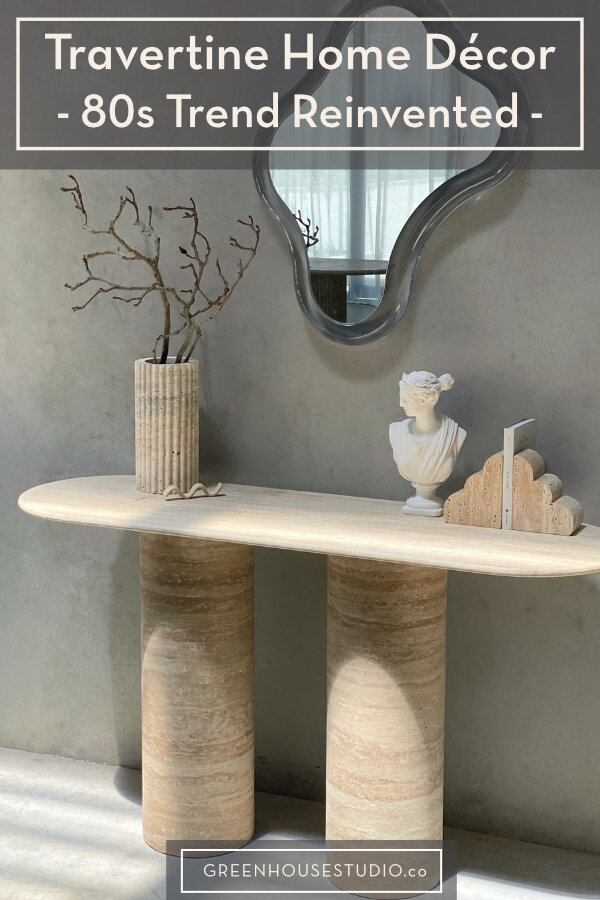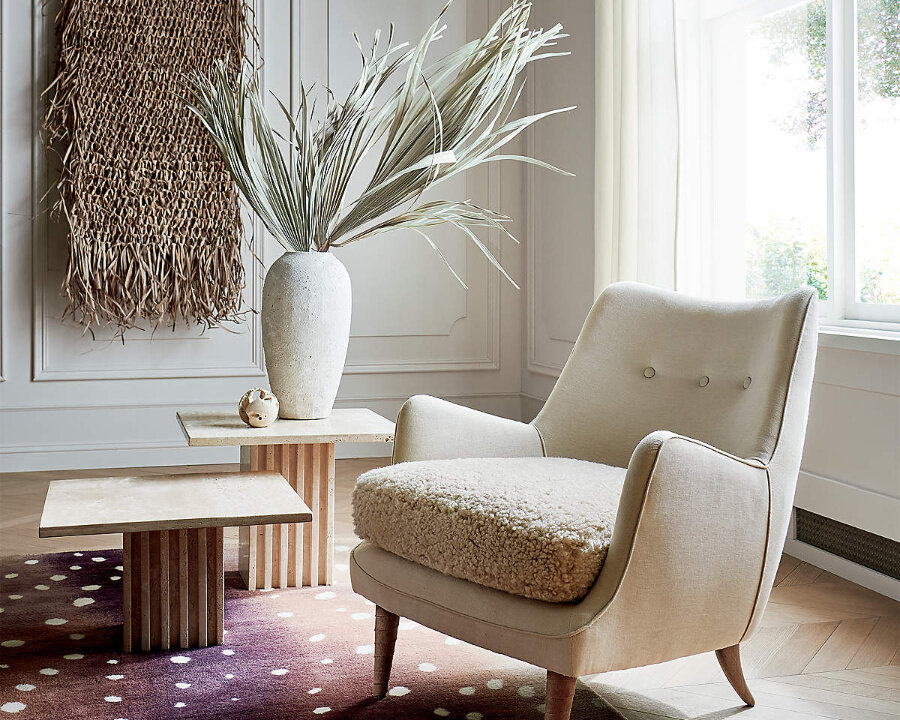Travertine Furniture & Accessories - 80s Trend Reinvented
Travertine furniture and décor have been trending hard. It’s no surprise really since the creamy, neutral color and organic texture of travertine and similar natural stone (travertine is a type of limestone) feed our desire for creating a warm, cozy, and nature-based home atmosphere.
In fact, travertine is one of the top home décor trends according to Etsy, likely fueled by the warm minimalism movement. This creamy, textured stone is the embodiment of neutral warmth and nostalgia. I for one, couldn’t be happier. I loves me some stone - furniture, décor, flooring - all of it. The heavier the better, am I right?
Image courtesy of En Gold. A rounded travertine table and accessories. Those art deco-inspired travertine cloud bookends are to die for.
First, let me start by qualifying what this travertine trend is and isn’t about. We aren’t talking the travertine flooring installed in so many homes during the late 90s and early 2000s to create the “Old World” Tuscan kitchen look (and now many of those homeowners are trying to deal with their Tuscan leftovers).
Instead, it’s travertine as seen in furniture and décor such as tabletops, lamp bases, and decorative accessories that have their design origins in late mid-century minimalism. More on this travertine trend’s design origins below. (Hint - it will look more than a bit familiar to those of you who closely follow current interior design trends.)
Trust me, travertine décor is a trend worth exploring, so come and take a look.
What is travertine?
Travertine furniture and home décor
80s “California Look” & travertine
[This post contains affiliate links. Click here to read my full disclosure.]
Anthropology's Anya travertine dining table showcases warm minimalism supported by curved organic forms, natural materials, and soft pops of pale pink.
What is travertine?
First things first. What exactly is travertine? Travertine is a form of limestone formed by rapid precipitation of calcium carbonate, often at the mouth of a hot spring or in a limestone cave. It’s characterized by pitted holes and troughs in its surface.
It can be left in it’s natural state or it can be filled and polished to a smooth, shiny finish. Travertine is most commonly found in white, tan, or cream colors, but can also range from grey to reddish-coral.
Travertine is mostly used as a building material, from ancient times until now. The Romans mined travertine for building everything from aqueducts to temples including the Colosseum. The Getty museum in Los Angeles is one of the best known modern examples of a travertine building.
Italy had a near-monopoly on the travertine market until the 1980s, but now much is also quarried in Turkey, Iran, Mexico, Peru, and even a couple of small repositories in the U.S.
This photography artwork from ABC Carpet & Home shows a natural travertine repository in Turkey.
A travertine furniture & décor love story
My travertine and limestone fetish started out with practical enough intentions. Back in about 2003 we were living in Santa Monica when I spotted a vintage travertine dining table with a wrought iron base for sale.
I was smitten and told myself “I must have that travertine dining table that requires 4 men to lift because it will hold up to toddler twin-boy destruction so much better than wood!” It became mine, and I was delighted, once it was safely hoisted into our rental house. (That was a white-knuckler.)
And yes, it really was a great worry-free surface that stayed looking beautiful no matter how much abuse those twin toddlers of mine doled out.
My vintage travertine and iron dining table now has a spot in the garden. Source | Greenhouse Studio
[Want more design inspo and helpful plant tips? Let's hang out on Instagram!]
From there my natural stone fetish evolved into more of an obsession. Next thing you know, I’m buying a vintage 1980s era limestone and brass coffee table a la Michael Taylor from a Bell Aire estate sale that I kept in a crate for 2 + years before actually getting to use it. And yeah, it still feels like the first time. After having it for more than 15 years, I’ll never part with it. Which is a good thing because I can’t move it anyway.
My vintage 1980s limestone and mixed-metal cocktail table. It actually has fossils imprinted into the stone. Source | Greenhouse Studio
Travertine furniture and home décor
Now that I’ve pulled back the curtain on my natural stone and travertine obsession, I want to convert you as well if you’re not already with me. Let’s take a look at the current evolution of travertine as furniture, décor, and accessories. Then we’ll take a look at it’s 70s - 80s retro origins.
One of the big reasons I love travertine and other natural stone is because it doesn’t compete with wood tones. Sometimes I feel like my space is in danger of getting “too busy” because of too many competing shades of wood (hello dining room). But at the same time you still need some combo of a coffee table, side tables, chairs, sofas etc., all of which typically have wood, right?
Enter travertine, limestone, light marble etc. - they’re like a breath of fresh air. These naturally light and neutral stones don’t add yet another shade of brown wood to your interior. Plus they offer the big bonus of providing a different texture to your room décor as well - a win-win in my book!
Antwerp based content creator Paulien Riemis designed her open plan dining area around this oval travertine dining table. Source | Polienne
The modern travertine table above by Scandinavian brand fermLiving through Burke Decor was originally inspired by Japanese minimalism. The simple design highlights the earthy neutral texture and veining of the travertine stone. The rectilinear form of the table provides contrast to the soft organic form of the sofa and the round, organic woven pendant light.
Designer and entrepreneur Steffanie Ball’s En Gold specializes in natural marble and stone furniture and decor. Source | @en._gold
An oval travertine side table from Anthropologie(left) and a travertine sphere (right) add dimension to a cozy neutral room with a nubby boucle chair and light wood tones against a backdrop of white classical architectural details.
Travertine side tables with a fluted base from CB2 look beautiful next to other natural materials including a shearling and linen chair and dried botanicals.
Travertine décor and accessories
In addition to hefty furniture, another fun way to incorporate travertine into your interiors is through smaller décor and accessories. (Plus they’re a whole lot easier to move around!)
Mid-century Italian sculptor Fratelli Mannelli created geometric travertine objects like the vintage elephant bookend above. His work along with similar travertine decorative objects are experiencing a big resurgence in popularity. According to Etsy, searches for travertine decor are up 211% percent and travertine table searches are up 361% this year.
This adorable travertine table lamp by Burke Decor taps into the popular mushroom trend yet is also timeless.
Again, most travertine is creamy white or tan, but here we see a more unusual gray color in Creative Co-op’s gray travertine serving tray via Amazon.
Studio McGee's travertine spheres make simple, neutral, and textured decorative accessories.
Travertine’s 80s “California Look” minimalism
Should the 1980s and minimalism be used in the same sentence? By most accounts, a resounding NO. Much of 80s design was over the top for sure, but 1980s travertine was largely put on the map by super-designer Michael Taylor. He was known as the pioneer of the “California Look” which was in part a response to the excess and formality that characterized much of 1980s design.
According to Michael Taylor Designs, his philosophy was “…when you take something out, you must increase the size of what’s left.” In other words, avoid clutter and scale up. (Get more decluttering tips here, and learn about scaling up in How To Design A Room.)
He was known for white-walled, light-filled rooms with boldly over-scaled furniture and copious use of natural stone and decorative objects that evoked a rustic, nature-inspired glamour.
Check out the images below and see for yourself:
I’d be right at home in this room today with it’s ancient looking urns on open shelves, serene white walls, curvy, cozy chair, and boulders for tables. Interior Design by Michael Taylor. Source | @michaeltaylorcollections
Interior Design by Michael Taylor. Source | Architectural Digest
Interior Design by Michael Taylor. Source | Architectural Digest
Interior Design by Michael Taylor. Source | Architectural Digest
These Michael Taylor interiors are the definition of timeless, and between the stone décor plus the curvy, white upholstered furniture, you can see more than a passing reference to them in images at the top of the post.
Final travertine thoughts
As I’ve made plain, I love travertine and natural stone and have put my money where my mouth is in many areas of my home. It’s durable, doesn’t compete with wood tones, and is organic in color and texture. It definitely helps bring the outdoors in, as you may have guessed, I’m all about that.
Leave a comment below and let me know what do you think about this travertine resurgence.
[Want more design inspo and helpful plant tips? Let's hang out on Instagram!]
Other posts you’ll love:
How To Bring The Outside Inside [Natural Interior Styling In 6 Simple Steps]
How to create a mood board to design your space (3 easy options)
How to design a room (a home decorating step by step guide)
Enjoy the post? Pin it for later!



















